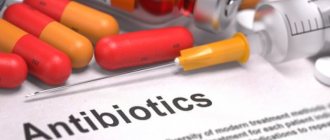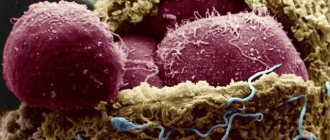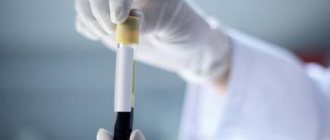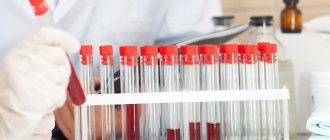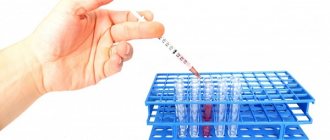Medical Consultant Analyzes PCR analysis - advantages, explanation and description of the method
People first started talking about PCR analysis in 1983. This technique was developed by Kary Mullis and members of his laboratory. Since then, the popularity of the study has been steadily increasing, because it has a significant number of advantages over other methods.
Today, PCR diagnostics is the benchmark or standard in identifying infections and pathogens, especially those that are asymptomatic. First of all, this is preclinical diagnostics.
- Advantages of PCR diagnostics
- PCR analysis for infections
- Preparing for the test
- Decoding the PCR result
- How accurate is PCR diagnostics?
PCR analysis, what is it?
Carrying out analysis in a PCR machine
The essence of PCR analysis is that nucleic acid sequences (DNA or RNA) characteristic of a certain type of pathogen are cloned (increased many times) in a test tube.
The abbreviation PCR stands for polymerase chain reaction.
The main distinguishing feature of this method is amplification, i.e. creating a huge number of copies of the required gene or its fragment. All this is produced outside the body, i.e. in vitro.
So, if 20 PCR cycles are carried out, then approximately 1 million copies or more are obtained. This makes it possible to detect an infection even when its quantity is insignificant in the source material, when other methods of analysis are powerless. This determines the high sensitivity of this method.
In simple words, you can draw the following analogy: you won’t notice one small grain of sand on the floor, but after increasing the number of grains of sand a million times (PCR), a pile of sand will already be clearly visible.
Pros and cons of PCR
When reflecting the advantages of PCR, it should be noted:
- sensitivity. As mentioned above, even a single agent left by the pathogen makes it possible to detect an infection at its early stage or if it occurs covertly;
- wide spectrum. For example, PCR 6 allows one test to identify as many as 6 pathogens;
- accuracy. False results with this research method do occur, but their number is kept to a minimum;
- speed. As a rule, the patient can pick up the finished PCR test result the very next day.
- price. PCR testing is not included in the list of studies in the compulsory medical insurance system. Expensive high-precision equipment requires payment for its work;
- requirements for compliance with research techniques and professionalism of employees;
- training requirements.
Advantages of PCR diagnostics
The main advantages of testing for infections using the PCR method are:
- the highest sensitivity and specificity in comparison with other methods used to detect infectious agents;
- the ability to detect microorganisms in a variety of biological materials (blood, urine, vaginal secretions, saliva, etc.);
- the ability to simultaneously identify several causative microorganisms, if any. For comparison, the use of bacteriological methods does not provide such an opportunity, because it is necessary to use different media for growing various pathogenic microbes;
- the possibility of transporting biological material, because To identify a pathogen, it is not necessary to keep it alive;
- speed of analysis;
- accuracy of the etiological diagnosis;
- the possibility of quantitative determination of pathogens - especially important for opportunistic microbes, which only after reaching a certain concentration are capable of causing disease;
- the ability to control the course of the infectious process during treatment.
Reliability of the PCR method
There are three criteria to evaluate the effectiveness of the technique:
- Accuracy
– detection of infection (or lack thereof) with a high degree of probability.
— Specificity
– accuracy of identifying a specific pathogen.
— Sensitivity
– the ability to identify the pathogen even with a small amount of genetic material in biological samples.
When using the PCR method, obtaining false positive results is almost impossible (that is, if the pathogen is absent, the sample will not be positive).
A false negative result is possible, but it is quite rare. Similar situations arise if the infection is inactive at the time of the study. For example, a chronic infection without activity or a latent infection.
PCR analysis for infections
Currently, the majority of sexually transmitted (and other) infectious diseases are determined using the polymerase chain reaction method. Diagnostics has become widespread due to its high sensitivity and specificity.
PCR analysis for chlamydia is especially popular.
This is due to the fact that these microorganisms live intracellularly, which creates certain difficulties in their detection.
PCR diagnostics makes it possible to detect even a minimal amount of chlamydia, which, as a rule, does not yet lead to the appearance of clinical symptoms. Even the presence of only 2 molecules of nucleic acids in the test material makes it possible to identify the causative infection.
And this is the key to successful treatment, which begins at the preclinical stage.
Infections are also determined:
- HIV;
- viral hepatitis;
- tuberculosis;
- tick-borne encephalitis;
- various sexually transmitted diseases, etc.
PCR diagnostics allows you to solve a number of other important problems:
- monitoring therapy and assessing its effectiveness;
- determination of the “virus load”, on the basis of which an individual dose of the drug is selected;
- identification of strains of microorganisms that are pharmacologically resistant (insensitive to drugs).
Preparation and collection of material
The following biomaterials are suitable for diagnosing urogenital infections:
- A smear (scraping of the epithelium) from the urethra;
- Prostate juice;
- Sperm;
- Blood (when analyzed for cytomegalovirus, hepatitis, herpes, HIV);
- Urine.
If there are signs of genitourinary infections and during preventive examinations, a smear from the urethra is most often taken for examination. To preserve all the microflora present on its walls, you should abstain from sex for two days, and not urinate for 3-4 hours. For 2-3 days you need to refrain from drinking alcohol, spicy, smoked, salty foods (so as not to irritate the walls of the bladder and urethra).
The process of collecting a smear from the urethra can be unpleasant, but tolerable. Residual effects in the form of pain when urinating go away on their own within two days
The scraping process is painful, because at the end of a thin probe inserted into the urethra there is a brush that scrapes off particles of the inner lining (epithelium). The pain may persist for another 2-4 days, intensifying with urination. Not all men experience such symptoms, but many complain. You can relieve discomfort with the help of Katedzhel gel.
Preparing for the test
There is no need to specifically prepare for the test, which will be carried out using the PCR method. However, it is very important that the specialist collects the material in compliance with all necessary sterility conditions.
So, for example, special vacuum systems should be used to take blood, special tubes should be used to take genital secretions, etc.
In some cases, the material must be transported to the laboratory. To do this correctly, it is necessary to hermetically seal the container with biological material. This will prevent the penetration of other microorganisms living in the external environment.
General information about urine testing for men and women
The first urine sample in the morning, its middle portion, should be tested. In other words, you should start urinating in the toilet. Then stop the act of urination, place a jar under the urethra to collect urine, continue urinating for 2-3 seconds, then stop urinating again and, removing the container, finish the act of urinating into the toilet.
Before taking a PCR test, women and men should wash their external genitalia well to prevent smegma (a mixture of secretions from the sebaceous glands of the foreskin) and vaginal discharge from getting into the urine.
The urine jar must be sterile. Ask for a container at the clinic where you are getting tested, or prepare a jar with a tight-fitting lid in advance and boil for at least 10 minutes.
Immediately before taking the PCR test, it is prohibited to:
- urinate (the very first portion of urine of the day is necessary);
- change the amount of fluid you drink the day before the test. This is necessary to maintain the normal water and electrolyte balance of the body, in which a potential infectious agent feels comfortable;
- use uroseptics;
- use soap containing an antibiotic;
- have sex 12 hours before the test;
- during menstruation, it is advisable to collect urine with a urethral catheter to prevent blood from entering the container with urine;
If one of the points was violated:
You should refrain from diagnosing infections using PCR. If, however, the test was passed, it should be repeated after two days. If the result turned out to be “good” when using antiseptics and antibiotics, do not rejoice. Most likely, if there are certain complaints, this is a false positive result.
The child had jaundice, can he be vaccinated against hepatitis?
Decoding the PCR result
The results of PCR analysis can be of two options:
- positive – pathogen detected;
- negative – the pathogen has not been identified.
You should know that even in the absence of clinical symptoms, a positive result can be obtained.
In this case, it is necessary to focus on the polymerase reaction data, because
it allows you to identify the disease at the preclinical stage. Sometimes a questionable answer may be obtained when the number of detected copies corresponds to the upper limit of normal. To clarify the cause of the disease, the analysis should be repeated, paying special attention to the conditions for collecting biological material.
The essence of the technique and scope of application
The analysis is based on the principles of molecular biology. PCR research involves using a special enzyme that, under the influence of temperature conditions, copies the RNA and DNA of bacteria and viruses present in the collected biomaterial. Such mass reproduction allows the doctor to determine exactly what species the bacterium that caused the disease belongs to, as well as measure the level of its concentration in the biomaterial. The copying procedure is carried out in a special apparatus - a thermal cycler, which heats and cools the test tubes with the collected material, creating convenient conditions for replication.
PCR testing is carried out for many reasons, but most often it is used to determine the presence of infectious diseases such as:
- HIV;
- herpes;
- sexually transmitted infections - chlamydia, ureaplasmosis, gardnerellosis, trichomoniasis;
- candidiasis;
- hepatitis;
- mononucleosis;
- listeriosis;
- cytomegalovirus;
- tuberculosis;
- human papillomavirus;
- tick-borne encephalitis.
PCR analysis is not limited to its application in medicine; screening is often done if it is necessary to understand who owns the biological material found at a crime scene, that is, PCR analysis is widely used in forensic science. It should be noted that a smear or blood is taken for PCR if paternity needs to be established. The results of PCR diagnostics are in no way inferior to the usual DNA kinship analysis, and they are much cheaper.
What does a general blood test show during pregnancy? 304095
What other material is taken for PCR research?
Doctors separately identify pathologies called extragenital. In this case, we are often talking about sexually transmitted pathology, which is localized in its symptoms not in the genital area, but, for example, in the area of the anus or oral cavity. Naturally, in this case, a classic smear or urine test will not have a significant effect during the study. To exclude extragenital pathologies, samples of material can be taken from various areas.
For example:
- A PCR smear from the anus in men is taken for evaluation if a representative of the stronger sex has a large number of condylomas in the anus
- It is worth taking a smear from the mucous membrane of the eye if you suspect damage to this area by one of the pathogens
- It is often not superfluous to study sperm, which allows us to determine the presence in the body of sluggish processes that affect the deep parts of the genitourinary system
- An oral smear is given if oral sex has been practiced and there is a suspicion of the development of the oral form of the disease
In some cases, it is recommended to perform PCR of prostate secretions in men. The study allows you to identify bacterial, viral or fungal prostatitis, identify the causative agent of the disease, and give recommendations for the treatment of the pathological process.
